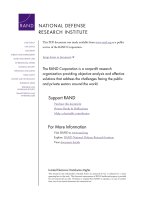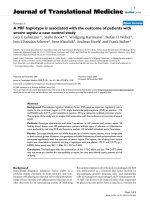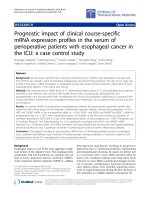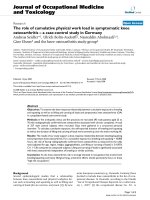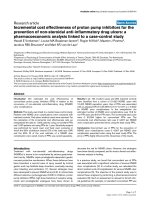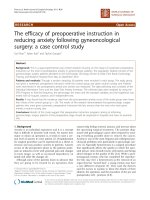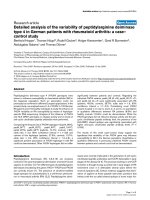A case–control study on the association between bladder cancer and prior bladder calculus
Bạn đang xem bản rút gọn của tài liệu. Xem và tải ngay bản đầy đủ của tài liệu tại đây (245.89 KB, 6 trang )
Chung et al. BMC Cancer 2013, 13:117
/>
RESEARCH ARTICLE
Open Access
A case–control study on the association between
bladder cancer and prior bladder calculus
Shiu-Dong Chung1,2,5, Ming-Chieh Tsai3, Ching-Chun Lin4 and Herng-Ching Lin2,5*
Abstract
Background: Bladder calculus is associated with chronic irritation and inflammation. As there is substantial
documentation that inflammation can play a direct role in carcinogenesis, to date the relationship between stone
formation and bladder cancer (BC) remains unclear. This study aimed to examine the association between BC and
prior bladder calculus using a population-based dataset.
Methods: This case–control study included 2,086 cases who had received their first-time diagnosis of BC between
2001 and 2009 and 10,430 randomly selected controls without BC. Conditional logistic regressions were employed
to explore the association between BC and having been previously diagnosed with bladder calculus.
Results: Of the sampled subjects, bladder calculus was found in 71 (3.4%) cases and 105 (1.1%) controls.
Conditional logistic regression analysis revealed that the odds ratio (OR) of having been diagnosed with bladder
calculus before the index date for cases was 3.42 (95% CI = 2.48-4.72) when compared with controls after adjusting
for monthly income, geographic region, hypertension, diabetes, coronary heart disease, and renal disease, tobacco
use disorder, obesity, alcohol abuse, and schistosomiasis, bladder outlet obstruction, and urinary tract infection. We
further analyzed according to sex and found that among males, the OR of having been previously diagnosed with
bladder calculus for cases was 3.45 (95% CI = 2.39-4.99) that of controls. Among females, the OR was 3.05 (95% CI =
1.53-6.08) that of controls.
Conclusions: These results add to the evidence surrounding the conflicting reports regarding the association
between BC and prior bladder calculus and highlight a potential target population for bladder cancer screening.
Keyword: Bladder cancer, Bladder calculus, Case–control study
Background
Urinary calculi (UC) is a common genitourinary disorder
with a worldwide lifetime incidence of 10–15% [1]. With
the exception of the two World Wars, the incidence of
UC has been increasing among both adults and children
over the past 100 years [2-4]. Therefore, on account of
the relatively high and increasing incidence rate of UC,
it is important to understand what sequelae may affect
the many survivors of this low-mortality condition.
Bladder cancer (BC) is one of the most common human cancers [5]; in the United States it is fifth most
commonly diagnosed cancer [6], and the eighth most
common cause of death among men with cancer [7]. In
* Correspondence:
2
School of Health Care Administration, Taipei Medical University, 250 WuHsing St, Taipei 110, Taiwan
5
Sleep Research Center, Taipei Medical University Hospital, Taipei, Taiwan
Full list of author information is available at the end of the article
the United States alone, nearly 44,690 men and 16,730
women were diagnosed with bladder cancer in 2006 [8],
and the incidence has also been reported to be increasing [9]. It has been proposed that the chronic irritation
and inflammation associated with UC may cause alterations in the local environment and subsequently lead
to urothelial proliferation and the development of malignant neoplasms, especially transitional cell carcinoma
(TCC) [10].
While the incidence of BC is high in most developing
countries, its chief etiology is different from that of developed countries. Most cases in developing countries
occur on account of infections with members of the
genus Schistosoma, with 75% of all BC cases being squamous cell carcinomas [8,9]. This stands in contrast to
BC cases in developed countries such as the United
States, where TCC is reported to be the pathology
© 2013 Chung et al.; licensee BioMed Central Ltd. This is an Open Access article distributed under the terms of the Creative
Commons Attribution License ( which permits unrestricted use, distribution, and
reproduction in any medium, provided the original work is properly cited.
Chung et al. BMC Cancer 2013, 13:117
/>
among over 90% of BC cases [11,12]. Therefore, it is
possible that the inflammation stemming from bladder
calculus may be associated with BC. Although urinary
tract infections have previously been considered to be a
risk factor [13-15], to date the relationship between
stone formation and BC remains unclear [16,17]. Therefore, using a population-based dataset in Taiwan, this
study set out to explore the association of BC with a
previous diagnosis of bladder calculus.
Page 2 of 6
Exposure assessment
We identified cases with bladder calculus by ICD-9-CM
codes 594.0 (calculus in diverticulum of bladder) or
594.1 (other calculus in bladder) prior to index date. In
order to ensure for high diagnostic validity, we only selected cases who had more than one bladder calculus
diagnostic claim, with at least one diagnosis being made
by a urologist or nephrologist.
Statistical analysis
Methods
Database
We obtained the data for the analyses performed in this
study from the Longitudinal Health Insurance Database
2000 (LHID2000), which is derived from the Taiwan National Health Insurance (NHI) program. The LHID2000
comprises all the registration files and medical claims
for the reimbursement of 1,000,000 beneficiaries, and is
provided to scientists in Taiwan for research purposes.
The selected beneficiaries of the LHID2000 were randomly retrieved from the year 2000 Registry of Beneficiaries (n = 23.72 million) of the NHI program. The
Taiwan National Health Research Institute has demonstrated that the sex distribution of the LHID2000 is representative of the whole population of NHI enrollees.
Numerous researchers have used this dataset to perform
and publish studies in internationally peer-reviewed
journals.
As the LHID2000 consists of de-identified secondary
data released to the public for research purposes, this
study was exempted from full review after consulting
with the director of the Institutional Review Board (IRB)
of Taipei Medical University.
The SAS statistical package (SAS System for Windows,
Version 8.2, Cary, NC) was used to perform all the statistical analyses conducted in this study. We utilized
Pearson χ2 tests to examine the distribution of
sociodemographic characteristics (monthly income and
geographic region (Northern, Central, Eastern, and
Southern Taiwan)) and the prevalence of co-morbidities.
The prevalence of comorbidities, including hypertension
(ICD-9-CM codes 401 ~ 405), diabetes (ICD-9-CM code
250), coronary heart disease (CHD) (ICD-9-CM codes
410 ~ 414), renal disease (ICD-9-CM codes 582 ~ 586),
tobacco use disorder (ICD-9-CM code 305.1), obesity
(ICD-9-CM code 278), alcohol abuse (ICD-9-CM codes
303), schistosomiasis (ICD-9-CM code 120), bladder
outlet obstruction (ICD-9-CM code 596.0), and urinary
tract infections (ICD-9-CM codes 599.0, 595.0, or 595.9)
within 3 years prior to the index date were included
[8,11,16]. Conditional logistic regressions (conditioned
on sex, age group, urbanization level, and index year)
were employed to explore the association between BC
and having been previously diagnosed with bladder calculus. We further computed the odds ratio (OR) for having been previously diagnosed with bladder calculus
stratified by sex. The conventional p ≤ 0.05 was used to
assess statistical significance.
Selection of cases and controls
We selected cases by identifying those patients (n =
2,086) ≥ 40 years old who had received their first-time
diagnosis of BC (ICD-9-CM codes 188 or 188.0-188.9)
in ambulatory care visits or hospitalizations between
January 1, 2001 and December 31, 2009. We assigned
the date of their first-time diagnosis of BC as their index
date.
For controls, we selected five subjects for each case
from the remaining beneficiaries in the LHID2000. In
total, 10,430 subjects were frequency-matched with cases
by sex, 10-year age groups (40–49, 50–59, 60–69, 70–
79, and >79), urbanization level of the patient’s residence
(5 levels, with 1 referring to the “most urbanized”, and 5
the “least urbanized”), and index year and selected as
controls. Controls were matched with cases in terms of
urbanization level to help assure that cases and controls
were reasonably similar in regard to unmeasured neighborhood socioeconomic characteristics.
Results
The mean age for the 12,516 sampled patients was 64.4 years with a standard deviation of 16 years. Table 1
shows the distribution of sociodemographic characteristics and co-morbidities between cases and controls.
After matching for sex, age group, urbanization level,
and index year, there was no significant difference in
monthly income, geographic region, CHD, and diabetes
between cases and controls. However, cases were more
likely to have renal disease (p < 0.001), urinary tract infection (p < 0.001), tobacco use disorder (p < 0.001), but
less likely to have hypertension (p = 0.018), than controls. No sampled subjects had ever received a diagnosis
of schistosomiasis since the initiation of the NHI
program.
Table 2 shows the prevalence of prior bladder calculus
between cases and controls. Of 12,516 sampled subjects,
176 (1.4%) had bladder calculus prior to the index date;
Chung et al. BMC Cancer 2013, 13:117
/>
Page 3 of 6
Table 1 Demographic characteristics of patients with bladder cancer and comparison group patients in Taiwan,
2001–2009 (n = 12,516)
Variable
Patients with bladder cancer
Comparison patients
n = 2,086
n = 10,430
Total No.
Column %
Total No.
Column %
40-49
287
13.8
1,435
13.8
50-59
377
18.1
1,885
18.1
60-69
482
23.1
2,410
23.1
70-79
604
28.9
3,020
28.9
>79
336
16.1
1,680
16.1
1,332
63.9
6,660
63.9
754
36.1
3,770
36.1
Age
1.000
Sex
Male
Female
1.000
Urbanization level
1.000
1 (most urbanized)
707
33.9
3,535
33.9
2
568
27.2
2,840
27.2
3
276
13.2
1,380
13.2
4
290
13.9
1,450
13.9
5 (least urbanized)
245
11.7
1,225
11.7
Monthly income
0.963
NT$0-15,840
770
36.9
3,817
36.6
NT$15,841-25,000
903
43.3
4,537
43.5
≥NT$25,001
413
19.8
2,076
19.9
Geographical Region
Northern
P value
0.911
1,017
48.7
5,006
48.0
Central
438
21.0
2,222
21.3
Southern
581
27.9
2,962
28.4
Eastern
50
2.4
240
2.3
Hypertension
972
46.6
5,155
49.4
0.018
Renal disease
332
15.9
73
7.0
<0.001
Coronary heart disease
455
21.8
2,445
23.4
0.107
Diabetes
452
21.7
2,190
21.0
0.493
Schistosomiasis
0
–
0
–
–
Bladder outlet obstruction
35
1.7
146
1.4
0.307
Urinary tract infection
724
34.7
2,931
28.1
<0.001
Tobacco use disorder
110
5.3
350
3.4
<0.001
Alcohol abuse
20
1.0
100
1.0
0.998
Obesity
30
1.4
98
1.0
0.145
bladder calculus was found in 71 (3.4%) cases and in 105
(1.1%) controls (chi-square value = 72.036; p < 0.001).
Conditional logistic regression analysis (conditioned on age
group, sex, urbanization level, and index year) revealed that
the OR of having been diagnosed with bladder calculus before the index date for cases was 3.47 (95% CI = 2.55-4.70;
p < 0.001) when compared with controls. After adjusting
for monthly income, geographic region, hypertension,
diabetes, CHD, and renal disease, tobacco use disorder,
obesity, alcohol abuse, and schistosomiasis, bladder outlet
obstruction, and urinary tract infection, cases were more
likely to have a prior diagnosis of bladder calculus than
controls (OR = 3.42; 95% CI = 2.48-4.72; p < 0.001).
We further analyzed the OR of having been previously
diagnosed with bladder calculus according to sex
(Table 3). After adjusting for patient monthly income,
Chung et al. BMC Cancer 2013, 13:117
/>
Page 4 of 6
Table 2 Covariate-adjusted hazard ratios for bladder
calculus among the sampled patients
Table 3 Covariate-adjusted hazard ratios for bladder
calculus among the sampled patients, by sex
Variable
Variable
Bladder cancer
Odds ratio
95% CI
P value
3.42
2.48-4.72
<0.001
Prior bladder calculus
Yes
No (reference group)
1.00
Female
Bladder cancer
OR (95% CI)
3.45*** (2.39-4.99)
3.05** (1.53-6.08)
1.00
1.00
Prior bladder calculus
Yes
Monthly Income
Sex
Male
Bladder cancer
OR (95% CI)
No (reference group)
NT$1-15,840 (reference group)
1.00
NT$15,841-25,000
0.98
0.97-1.01
0.317
NT$1-15,840 (reference group)
1.00
1.00
≥NT$25,001
1.01
0.98-1.02
0.891
NT$15,841-25,000
1.21* (1.05-1.40)
1.24* (1.03-1.49)
≥NT$25,001
1.33** (1.13-1.57)
1.47** (1.12-1.92)
Monthly Income
Geographic region
Northern (reference group)
1.00
Central
0.92
0.80-1.07
0.279
Eastern
0.98
0.86-1.11
0.692
Southern
Geographic region
0.94
0.68-1.31
0.722
Hypertension
0.80
0.72-0.89
0.008
Renal disease
2.65
2.28-3.08
<0.001
Coronary heart disease
0.87
0.73-1.05
0.060
Diabetes
0.98
0.86-1.11
0.742
Bladder outlet obstruction
0.90
0.46-1.76
0.751
Urinary tract infection
1.23
1.07-1.38
<0.001
Tobacco use disorder
1.46
1.26-1.68
<0.001
Alcohol abuse
0.99
0.88-1.44
0.983
Obesity
1.03
0.98-1.06
0.056
Notes: CI = confidence interval; OR was calculated using Cox proportional
hazard regression, stratified by sex, age, and urbanization level group.
Northern (reference group)
1.00
1.00
Central
0.98 (0.83-1.17)
0.83 (0.65-1.07)
Eastern
1.06 (0.90-1.23)
0.86 (0.70-1.07)
Southern
1.09 (0.73-1.62)
0.74 (0.42-1.32)
0.88 (0.77-1.01)
0.69*** (0.57-0.82)
Hypertension
Renal disease
1.94*** (1.60-2.37) 4.37*** (3.44-5.55)
Coronary heart disease
0.73** (0.63-0.86)
1.03 (0.83-1.28)
0.95 (0.81-1.12)
1.04 (0.85-1.28)
Diabetes
Bladder outlet obstruction
0.90 (0.45-1.79)
0.45 (0.02-13.73)
Urinary tract infection
1.08*** (1.04-1.11)
1.53 (1.47-1.58))
Tobacco use disorder
1.29*** (1.13-1.48) 1.68*** (1.62-1.74)
Alcohol abuse
0.95 (0.83-1.09)
0.99 (0.95-1.03)
Obesity
1.03 (0.99-1.06)
1.07 (0.99-1.12)
Notes: OR was calculated using Cox proportional hazard regression, stratified
by age and urbanization level group.
geographic region, hypertension, diabetes, CHD, and
renal disease, tobacco use disorder, obesity, alcohol
abuse, and schistosomiasis, bladder outlet obstruction,
and urinary tract infection, conditional logistic regression analysis revealed that among males, the OR of having been previously diagnosed with bladder calculus for
cases was 3.45 (95% CI = 2.39-4.99; p < 0.001) that of
controls. Among females, the OR of having been previously diagnosed with bladder calculus for cases was
3.05 (95% CI = 1.53-6.08; p = 0.002) that of controls.
Discussion
This study succeeded in identifying an association between BC and a prior diagnosis of bladder calculus. We
found bladder cancer patients to be 3.42 times more
likely than controls to have had a previous diagnosis of
bladder calculus. We also found the magnitude of association to be significantly stronger among men than
among women. Men with BC were 3.45 times more
likely than controls to have had a previous diagnosis of
bladder calculus, while women were only 3.05 times
more likely.
Several previous studies have been conducted on this
association, but their results are in conflict. The largest
case–control study performed to date set out to evaluate
the role of urinary tract infection (UTI) and inflammation in the etiology of BC and was conducted on 2,982
bladder carcinoma patients and 5,782 population controls from ten geographic areas of the United States.
They found a history of UTI to significantly increase the
risk of BC. This was stronger in individuals with three
or more reported infections (RR = 2.0). But, irrespective
of UTI, they also found a significantly increased risk of
BC among patients with bladder stones (RR = 1.8) [18].
There were two other studies conducted on the association between bladder calculus and BC, but they failed
to detect an association [17,19]. The first of these investigations was a population-based study conducted in
Greater Copenhagen between 1979 and 1981. This study
included 388 patients with BC and 790 controls [18].
The second study investigated the relationship between
selected urinary tract and genital diseases and the risk of
Chung et al. BMC Cancer 2013, 13:117
/>
BC. In their case–control study, they analyzed that data
of 364 cases of BC and 447 controls hospitalized for
acute, nonneoplastic, nongenital tract conditions, unrelated to known or suspected risk factors for BC.
As opposed to these studies which failed to detect an
association between bladder calculus and BC, the results
of this investigation support the presence of an association and are in-line with the one previous large-scale
study [18]. The mechanisms underlying the associations
detected in this study may involve the chronic irritation
and inflammation associated with bladder calculus. One
source of this inflammation is from the direct irritation
of the bladder epithelial wall and another may stem from
urinary tract infections which are strongly associated
with urinary stones [8,20].
There is substantial evidence that inflammation can
play a direct role in carcinogenesis [21,22]. Both infection and irritation can cause tissue injury and result in
the activation of both inflammatory cells and oxidantgenerating enzymes [22]. Chronic inflammation can induce tissue and deoxyribonucleic acid (DNA) damage by
generating reactive oxygen and nitrogen species [21,23].
The presence of stones and infections has been demonstrated to be important factors in the development of
bladder tumors in rodents. Furthermore, these tumors are
generally TCC [9], thus adding further evidence for a
mechanistic connection between BC and bladder calculus
in the absence of members of the genus Schistosoma.
This study’s strengths include the use of a populationbased dataset, which enabled us to trace of all the cases
of BC and bladder calculus during the study period. The
large sample size afforded a considerable statistical advantage in detecting real differences between the two cohorts. Nevertheless, the results of this study need to be
seen in the light of several limitations. The first limitation
is that the diagnoses of both BC and bladder calculus relied
on administrative claims data reported by physicians and
hospitals. These data may be less accurate than diagnoses
made according to standardized criteria.
Second, some patient information on factors which
may have had an effect on the associations detected in
this study was not available through the administrative
dataset. Some of those factors include tobacco use, alcohol and betel quid consumption, dietary habits, and the
body mass index. However, although we adjusted for tobacco use disorder in the regression model, this could
merely mean that those subjects with such a diagnosis
have undergone smoking cessation therapy. We might
underestimate to use the variable as tobacco smoke because the people who receive smoking cessation therapy
in clinic are only a small proportion of the smoker. One
other important factor that we lacked was any exposure
to aromatic amines which have been proven to contribute to the development of BC [11].
Page 5 of 6
Third, this study may have been partially victim to a
surveillance bias since patients with bladder calculus are
more likely to have frequent outpatient clinic visits. But,
as the first indication of BC is generally blood in the
urine, it is unlikely that surveillance bias impacted the
results of this study.
Conclusion
This investigation detected an association between BC
and prior bladder calculus after adjusting for co-morbid
medical disorders and social economic factors. These results add to the evidence surrounding the conflicting reports regarding the association between BC and prior
bladder calculus and highlight a potential target population for bladder cancer screening.
Abbreviations
BC: Bladder cancer; OR: Odds ratio; UC: Urinary calculi; TCC: Transitional cell
carcinoma; LHID2000: Longitudinal health insurance database 2000;
CHD: Coronary heart disease; DNA: Deoxyribonucleic acid; UTI: Urinary tract
infection.
Competing interests
The authors have no proprietary or commercial interest in any materials
mentioned in this article.
Authors’ contributions
Authors JJ and HC designed the study. Authors JJ, SB, CC, and HC managed
the literature searches. Authors CC and HC analyzed the data. Authors JJ, SB,
CC, and HC wrote the draft. All authors contributed to and have approved
the final manuscript.
Author details
1
Division of Urology, Department of Surgery, Far Eastern Memorial Hospital,
Ban Ciao, Taipei, Taiwan. 2School of Health Care Administration, Taipei
Medical University, 250 Wu-Hsing St, Taipei 110, Taiwan. 3Division of
Gastroenterology, Department of Internal Medicine, General Cathay Hospital,
Taipei, Taiwan. 4Graduate Institute of Biomedical Informatics, College of
Medical Science and Technology, Taipei Medical University, Taipei, Taiwan.
5
Sleep Research Center, Taipei Medical University Hospital, Taipei, Taiwan.
Received: 25 September 2012 Accepted: 4 March 2013
Published: 15 March 2013
References
1. Long LO, Park S: Update on nephrolithiasis management. Minerva Urol
Nefrol 2007, 59:317–325.
2. Goldfarb DS: Increasing prevalence of kidney stones in the United States.
Kidney Int 2003, 63:1951–1952.
3. Stamatelou KK, Francis ME, Jones CA, Nyberg LM, Curhan GC: Time trends in
reported prevalence of kidney stones in the United States: 1976–1994.
Kidney Int 2003, 63:1817–1823.
4. López M, Hoppe B: History, epidemiology and regional diversities of
urolithiasis. Pediatr Nephrol 2010, 25:49–59.
5. Burin GJ, Gibb HJ, Hill RN: Human bladder cancer: evidence for a
potential irritation-induced mechanism. Food Chem Toxicol 1995,
33:785–795.
6. American Cancer Society: Cancer facts & figures 2006. Am Cancer Soc,
Atlanta (GA) 2006.
7. Jacobs BL, Lee CT, Montie JE: Bladder cancer in 2010: how far have we
come? CA Cancer J Clin 2010, 60:244–272.
8. Michaud DS: Chronic inflammation and bladder cancer. Urol Oncol 2007,
25:260–268.
9. Johansson SL, Cohen SM: Epidemiology and etiology of bladder cancer.
Semin Surg Oncol 1997, 13:291–298.
Chung et al. BMC Cancer 2013, 13:117
/>
Page 6 of 6
10. Chow WH, Lindblad P, Gridley G, Nyrén O, McLaughlin JK, Linet MS,
Pennello GA, Adami HO, Fraumeni JF Jr: Risk of urinary tract cancers
following kidney or ureter stones. J Natl Cancer Inst 1997, 89:1453–1457.
11. Pelucchi C, Bosetti C, Negri E, Malvezzi M, La Vecchia C: Mechanisms of
disease: the epidemiology of bladder cancer. Nat Clin Pract Urol 2006,
3:327–340.
12. Silverman DT, Hartge P, Morrison AS: Epidemiology of bladder cancer.
Hematol Oncol Clin North Am 1992, 6:1–30.
13. Kantor AF, Hartge P, Hoover RN, Fraumeni JF Jr: Epidemiological
characteristics of squamous cell carcinoma and adenocarcinoma of the
bladder. Cancer Res 1988, 48:3853–3855.
14. Hartge P, Harvey EB, Linehan WM, Silverman DT, Sullivan JW, Hoover RN,
Fraumeni JF Jr: Unexplained excess risk of bladder cancer in men. J Natl
Cancer Inst 1990, 82:1636–1640.
15. Schottenfeld D, Fraumeni JF Jr, Silverman DT: Bladder cancer. In Cancer
epidemiology and prevention. 2nd edition. Edited by Schottenfeld D,
Fraumeni JF Jr. New York: Oxford University Press; 1996:1156–1179.
16. González CA, Errezola M, Izarzugaza I, López-Abente G, Escolar A, Nebot M,
Riboli E: Urinary infection renal lithiasis and bladder cancer in Spain. Eur J
Cancer 1991, 27:498–500.
17. Kjaer SK, Knudsen JB, Sørensen BL, Møller Jensen O: The Copenhagen
case–control study of bladder cancer. V. Review of the role of urinarytract infection. Acta Oncol 1989, 5:631–636.
18. Kantor AF, Hartge P, Hoover RN, Narayana AS, Sullivan JW, Fraumeni JF Jr:
Urinary tract infection and risk of bladder cancer. Am J Epidemiol 1984,
119:510–515.
19. La Vecchia C, Negri E, D’Avanzo B, Savoldelli R, Franceschi S: Genital and
urinary tract diseases and bladder cancer. Cancer Res 1991, 51:629–631.
20. Thomas B, Tolley D: Concurrent urinary tract infection and stone disease:
pathogenesis, diagnosis and management. Nat Clin Pract Urol 2008,
5:668–675.
21. Coussens LM, Werb Z: Inflammation and cancer. Nature 2002, 420:860–867.
22. Ohshima H, Tatemichi M, Sawa T: Chemical basis of inflammation-induced
carcinogenesis. Arch Biochem Biophys 2003, 417:3–11.
23. Hussain SP, Hofseth LJ, Harris CC: Radical causes of cancer. Nat Rev Cancer
2003, 3:276–285.
doi:10.1186/1471-2407-13-117
Cite this article as: Chung et al.: A case–control study on the association
between bladder cancer and prior bladder calculus. BMC Cancer 2013
13:117.
Submit your next manuscript to BioMed Central
and take full advantage of:
• Convenient online submission
• Thorough peer review
• No space constraints or color figure charges
• Immediate publication on acceptance
• Inclusion in PubMed, CAS, Scopus and Google Scholar
• Research which is freely available for redistribution
Submit your manuscript at
www.biomedcentral.com/submit
